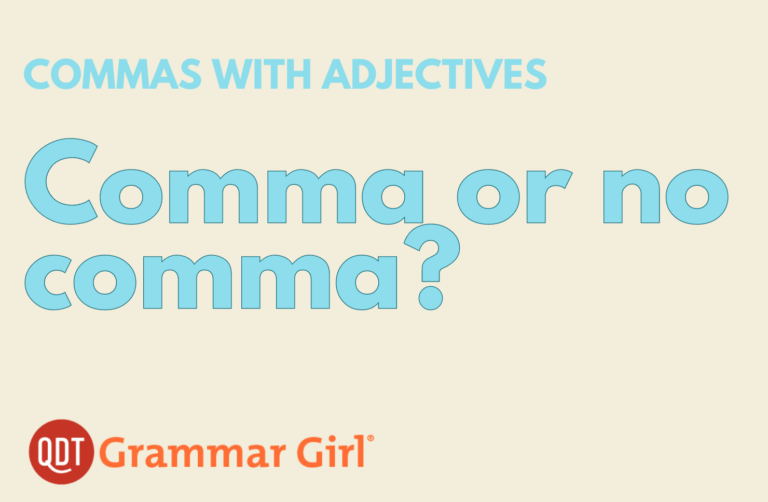When you use a string of adjectives, you often separate the adjectives with commas, as in “He is tall, dark, and handsome.” Sometimes, though, you don’t use a comma between two adjectives.
Coordinate adjectives versus cumulative adjectives
The comma rule comes down to the difference between two kinds of adjectives: coordinate adjectives and cumulative adjectives. Coordinate adjectives are adjectives in a row that each separately modify the noun that follows (1), as in “heavy, bulky box.” Both “heavy” and “bulky” modify “box.” You can even rearrange the adjectives and say, “bulky, heavy box.”
Cumulative adjectives, on the other hand, don’t separately modify the noun that follows even though they are all stacked up before the noun too (2). Instead, the adjective right before the noun pairs with the noun as a unit, and then adjective before that unit modifies that. An example will make this more clear: In the phrase “exquisite custom houseboat,” “custom” modifies “houseboat”—they become a unit—and then “exquisite” modifies “custom houseboat.”
If you try to rearrange the adjectives as we did for “heavy, bulky box,” you’ll run into a problem. The phrase “custom exquisite houseboat” is awkward, and it’s awkward precisely because you can’t rearrange cumulative adjectives.
Let’s say you have two adjectives in a row before a noun and you’re not sure whether they’re coordinate or cumulative. You can perform a simple test: Add the word “and” between the adjectives. If the phrase makes sense, the adjectives are coordinate; if not, they’re cumulative. For example, “It’s a bulky and heavy box” makes good sense but “It’s an exquisite and custom houseboat” does not.
Here’s a quick review so far: You can rearrange coordinate adjectives, and you can stick an “and” between them. As for cumulative adjectives, neither trick works.
Use commas when you could add an ‘and’
OK, I can tell—even from far away—that your head is spinning because of this esoteric terminology, when all you really want to know is what do commas have to do with these adjectives? Agreed. You don’t have to remember the names unless you want to impress your friends. Commas are what matter here.
To determine if we need a comma between two adjectives that precede a noun, we need to return to the “and” test. I’m sure you remember the tall, dark, and handsome man we mentioned at the beginning of the show. You could be wordy and say, “The tall and dark and handsome man.” If you can separate the adjectives with “and,” then you can separate the adjectives with commas. Also, if you can rearrange the adjectives, then you can separate them with commas. We started with “The tall, dark, handsome man,” but “The handsome and tall and dark man” works just as well.
A comma can change the meaning
Sometimes, a pair of adjectives can be both coordinate and cumulative. Let’s take the adjectives “deep” and “religious” and pair them with the noun “experience.” If we say, “She had a deep, religious experience,” we’re using coordinate adjectives: She had an experience that was both deep and religious (or religious and deep). Now, let’s get rid of the comma: “She had a deep religious experience.” Here, the religious experience was deep. The adjectives are cumulative. Granted, the difference between the two is quite subtle.
Summary and practice
Just remember that if you can reverse your two adjectives or can place an “and” between them, you need a comma.
And now our interesting, (comma) illuminating lesson has come to a close. Hope you had a grand old time (no comma there).
Answers to the Audio Quiz: 1) It’s an easy five-mile hike. 2) That was a long, hard run. 3) They endured a tough marital situation.
References
- Lutz, Gary, and Diane Stevenson. 2005. Grammar Desk Reference, pp. 209-210. Cincinnati: Writer’s Digest Books.
- Lutz, Gary, and Diane Stevenson. 2005. Grammar Desk Reference, pp. 209-210. Cincinnati: Writer’s Digest Books.




